最新广外英语文学欣赏U1教学内容
- 格式:ppt
- 大小:253.50 KB
- 文档页数:7
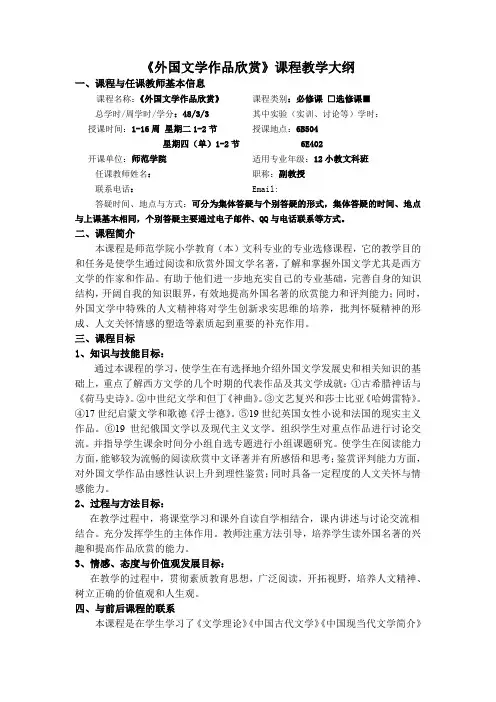
《外国文学作品欣赏》课程教学大纲一、课程与任课教师基本信息课程名称:《外国文学作品欣赏》课程类别:必修课□选修课■总学时/周学时/学分:48/3/3 其中实验(实训、讨论等)学时:授课时间:1-16周星期二1-2节星期四(单)1-2节授课地点:6B504 6E402开课单位:师范学院适用专业年级:12小教文科班任课教师姓名:职称:副教授联系电话:Email:答疑时间、地点与方式:可分为集体答疑与个别答疑的形式,集体答疑的时间、地点与上课基本相同,个别答疑主要通过电子邮件、QQ与电话联系等方式。
二、课程简介本课程是师范学院小学教育(本)文科专业的专业选修课程,它的教学目的和任务是使学生通过阅读和欣赏外国文学名著,了解和掌握外国文学尤其是西方文学的作家和作品。
有助于他们进一步地充实自己的专业基础,完善自身的知识结构,开阔自我的知识眼界,有效地提高外国名著的欣赏能力和评判能力;同时,外国文学中特殊的人文精神将对学生创新求实思维的培养,批判怀疑精神的形成、人文关怀情感的塑造等素质起到重要的补充作用。
三、课程目标1、知识与技能目标:通过本课程的学习,使学生在有选择地介绍外国文学发展史和相关知识的基础上,重点了解西方文学的几个时期的代表作品及其文学成就:①古希腊神话与《荷马史诗》。
②中世纪文学和但丁《神曲》。
③文艺复兴和莎士比亚《哈姆雷特》。
④17世纪启蒙文学和歌德《浮士德》。
⑤19世纪英国女性小说和法国的现实主义作品。
⑥19世纪俄国文学以及现代主义文学。
组织学生对重点作品进行讨论交流。
并指导学生课余时间分小组自选专题进行小组课题研究。
使学生在阅读能力方面,能够较为流畅的阅读欣赏中文译著并有所感悟和思考;鉴赏评判能力方面,对外国文学作品由感性认识上升到理性鉴赏;同时具备一定程度的人文关怀与情感能力。
2、过程与方法目标:在教学过程中,将课堂学习和课外自读自学相结合,课内讲述与讨论交流相结合。
充分发挥学生的主体作用。

高中英语课程《文学作品赏析》优质课公开课教案一、教学目标1. 通过本课的研究,学生将能够深入了解文学作品的内涵与艺术特点。
2. 培养学生的文学鉴赏能力,提高其阅读理解和表达能力。
3. 激发学生对文学的兴趣,培养其独立思考和创造力。
二、教学重点1. 能够准确理解文学作品的主题和情感表达。
2. 能够运用文学元素进行作品分析与评价。
3. 能够运用适当的语言表达对文学作品的理解和感受。
三、教学内容与安排1. 导入(5分钟)- 引入本课的主题,激发学生对文学作品的兴趣。
2. 正文(40分钟)- 第一部分:学生阅读一篇短篇小说,并提前准备问题,学生通过小组合作方式讨论并回答问题。
- 第二部分:教师讲解文学作品的主题和情感表达,并指导学生进行深入分析。
- 第三部分:学生展示自己对该文学作品的理解和评价,互相交流和借鉴。
3. 练与巩固(15分钟)- 学生完成一些练题,巩固对文学作品的理解和分析能力。
4. 结束(5分钟)- 引导学生进行总结,并激发学生对文学的进一步探索。
四、教学评价与反馈1. 教师通过观察学生的讨论和展示过程,评价学生对文学作品的理解和表达能力。
2. 学生根据教师提供的评价和反馈,反思自己的不足并进行改进。
五、教学资源1. 文学作品赏析教材。
2. 学生讨论和展示的材料准备。
3. 练题和评价反馈表。
六、教学拓展1. 鼓励学生参加文学作品的写作比赛或创意作品展示活动,培养学生的创造力与表达能力。
2. 组织学生参观文学展览或文学讲座,增加学生对文学的体验和了解。
以上就是本次高中英语课程《文学作品赏析》优质课公开课教案的内容和安排。
希望能够对您的教学工作有所帮助!。
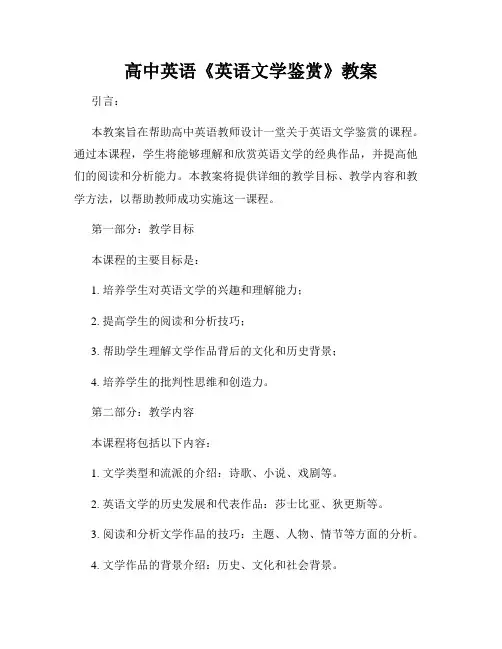
高中英语《英语文学鉴赏》教案引言:本教案旨在帮助高中英语教师设计一堂关于英语文学鉴赏的课程。
通过本课程,学生将能够理解和欣赏英语文学的经典作品,并提高他们的阅读和分析能力。
本教案将提供详细的教学目标、教学内容和教学方法,以帮助教师成功实施这一课程。
第一部分:教学目标本课程的主要目标是:1. 培养学生对英语文学的兴趣和理解能力;2. 提高学生的阅读和分析技巧;3. 帮助学生理解文学作品背后的文化和历史背景;4. 培养学生的批判性思维和创造力。
第二部分:教学内容本课程将包括以下内容:1. 文学类型和流派的介绍:诗歌、小说、戏剧等。
2. 英语文学的历史发展和代表作品:莎士比亚、狄更斯等。
3. 阅读和分析文学作品的技巧:主题、人物、情节等方面的分析。
4. 文学作品的背景介绍:历史、文化和社会背景。
5. 学生参与讨论和批判性写作的机会。
第三部分:教学方法为了达到上述教学目标和涵盖教学内容,我们将使用以下教学方法:1. 小组讨论:鼓励学生在小组内分享自己的观点和理解,促进学生之间的互动和合作。
2. 视听材料:使用音频和视频材料,帮助学生更好地理解和欣赏文学作品。
3. 分析和解读:教师将引导学生分析和解读文学作品的关键要素,如主题、人物和情节。
4. 写作练习:学生将有机会进行批判性写作,例如评论和分析文学作品。
第四部分:教学评估学生的学习将通过以下方式进行评估:1. 小组讨论:学生在小组内积极参与讨论,并分享自己的观点和理解。
2. 个人写作任务:学生将进行批判性写作,表达自己对文学作品的见解和评价。
3. 课堂测试:进行文学作品的相关测试,评估学生对于文学作品的理解程度。
结尾:通过本课程,学生将培养对英语文学的兴趣和欣赏能力,并提高他们的阅读和分析技巧。
这将对他们的英语学习和人文素养的培养产生重要影响。
希望本教案能够帮助教师顺利进行英语文学鉴赏的教学工作。
祝教师和学生们取得丰硕的教学成果!。
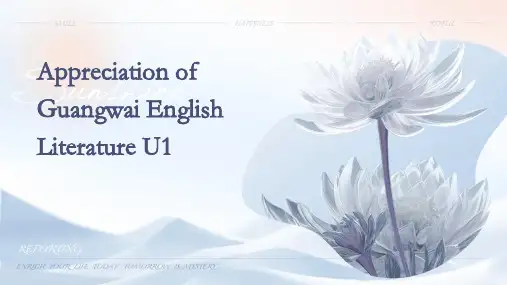
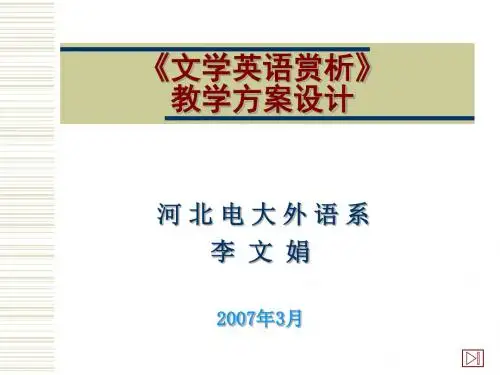
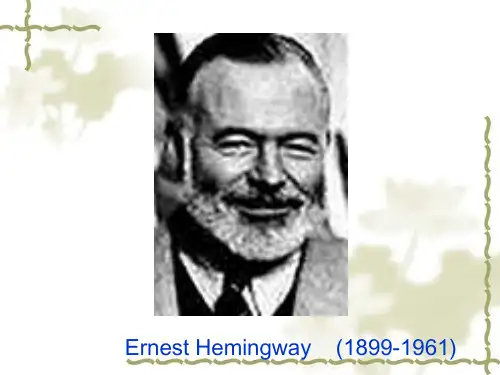
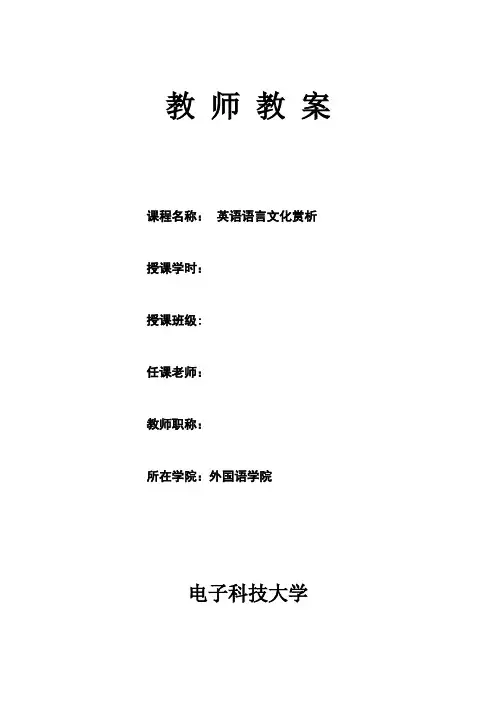
教师教案课程名称:英语语言文化赏析授课学时:授课班级:任课老师:教师职称:所在学院:外国语学院电子科技大学Table of ContentsUnit 1 Orientation (3)Unit 2 The Bible (5)Unit 3 Greek Myths (6)Unit 4 Shakespeare (8)Unit 5 Poetry (9)Unit 6 Speeches (10)Unit 7 Idioms (11)Unit 8 A Contrastive Study on Chinese and English (12)Unit One: Orientation(本单元4学时完成)I.Teaching contents and requirements (教学内容及要求)1.Contents➢Self-introduction➢Introduction to the Course➢Brief introduction to U.K. & U.S.A.2.Requirements➢Understanding the objective and contents of the course➢Coming to know assessment approaches and recommended readings ➢Grasping some basic facts about U.K & U.S.A.II Teaching Focus and Difficulties (教学重点及难点)1.Focus➢Contents of the course➢Assessment approaches➢Some basic facts about U.K & U.S.A.2. Difficulties➢The national flag and the national emblem➢Land and people➢PoliticsIII Procedures and Activities (教学步骤与教学活动)1.Self-introduction2.Introduction to the Course3.Brief introduction to U.K. & U.S.A.:A. the Official Name and NicknameB. the National FlagC. the National AnthemD. the National EmblemE. the National BirdF. Land and PeopleG. PoliticsH. EconomyI. A song: Candle in the WindIV Assignments (作业)Answer the following questions:1. What is the full name of U.K?2. What are the nicknames of U.K. and U.S.A?3. Which group of people is the largest minority group in the United States?4. What are the national birds of U.K and U.S.A?5. Please describe the separation of political powers in U.S.A..V References (参考资料)1. Oxford Advanced Learner's Dictionary of Current English with Chinese Translation2. Background to Britain, M.D. Munro Mackenzie & L.J. Westwood, Macmillan Publishers Ltd3. 《主要英语国家概况》, 周宝娣, 重庆大学出版社,20044. 《英语文化》, 王逢鑫, 北京大学出版社,20045. 《英语国家社会与文化入门》, 朱永涛,王立礼, 高等教育出版社, 2005VI Reflections (教学后记)Unit Two The Bible(本单元4学时完成)II.Teaching contents and requirements (教学内容及要求)3.Contents➢Lead-in listening activity➢ A brief introduction to the Bible➢Reading activity: Genesis 1, Ten Commandments➢Idioms from the Bible➢In-class exercises➢Assignment4.Requirements➢Having a basic knowledge about the Bible➢Be familiar with some idioms from the BibleII Teaching Focus and Difficulties (教学重点及难点)1.Focus➢Background information➢Idioms2. Difficulties➢Idioms➢ReadingIII Procedures and Activities (教学步骤与教学活动)4.Lead-in activities5. A brief introduction6.Reading activity7.Idioms8.ExercisesIV Assignments (作业)1. Think of 5 idioms in each category: idioms with colors, animals and nations V References (参考资料)1. 英语习语与英美文化2. 《圣经》的文学阐释3. The BibleVI Reflections (教学后记)Unit Three Greek Mythology (Part 1)(本单元2学时完成)I Teaching contents and requirements (教学内容及要求)2.Contents➢Introduction to Greek myths➢Idioms2. Requirements➢Having a basic knowledge about Greek myths➢Being familiar with some idioms and proverbs from themII Teaching Focus and Difficulties (教学重点及难点)1.Focus➢Introduction➢Idioms2. Difficulties➢Their origin➢The differences in the names given to Gods and Godesses in Greek and Roman myths III Procedures and Activities (教学步骤与教学活动)1.Introduction to Greece2.Introduction to Greek mythology3.IdiomsIV Assignments (作业)1. Explain the given idioms2. Think of the influences those myths have on our livesV References (参考资料)1. 希腊神话故事精选2. 各种网上资源VI Reflections (教学后记)Unit Three Greek Mythology (Part 2)(本单元2学时完成)I.Teaching contents and requirements (教学内容及要求)1.Contents➢More idioms from the Greek myths➢The zodiac and star sign2.Requirements➢Knowing more idioms from the Greek myths➢Comparing some of them with the Chinese mythII Teaching Focus and Difficulties (教学重点及难点)1.Focus➢Idioms➢Developing more culture awareness2. Difficulties➢The names of 12 star signs and their implicationsIII Procedures and Activities (教学步骤与教学活动)1.Assignment check2.More idioms and proverbs3.The zodiac and star signIV Assignments (作业)1. Choose a name from those Gods and Godnesses for yourself and explain why.V References (参考资料)1. 希腊神话故事精选2. 各种网上资源VI Reflections (教学后记)Unit Four Shakespeare(本单元4学时完成)I Teaching contents and requirements (教学内容及要求)1.Contents➢Life and time of Shakespeare➢appreciation & discussion of Shakespeare’s classics2.Requirements➢Learn about Shakespeare life and time➢Appreciate Shakespeare’s classic worksII Teaching Focus and Difficulties (教学重点及难点)1.Focus➢Shakespeare’s plays, poems and famous quotes2. Difficulties➢The understanding and translation of Shakespeare’s plays and poemsIII Procedures and Activities (教学步骤与教学活动)1. Shakespeare quiz2. Shakespeare’s life3. Shakespeare’s works4. Characteristics of William Shakespeare’s plays5. Shakespeare’s quotes6. Shakespeare’s sonnetsIV Assignments (作业)1. Appreciate some of Shakespeare’s classic plays: Hamlet, Merchant o f Venice, etc.2. Collect some frequently quotations from books or InternetV Reflections (教学后记)Unit Five: Poetry(本单元4学时完成)I Teaching contents and requirements (教学内容及要求)1. Contents➢background information of the poets➢appreciation & translation of poems2. Requirements➢Understanding what poetry is➢Coming to know some famous British and American poets and their poemsII Teaching Focus and Difficulties (教学重点及难点)1. Focus➢Background information of some famous British and American poets➢Their famous poems2. Difficulties➢The understanding and translation of poemsIII Procedures and Activities (教学步骤与教学活动)1. What is poetry?2. British poets and poetry:A. Robert BurnsB. William WordsworthC. John KeatsD. George Gordon ByronE. Percy Bysshe ShellyF. Benjamin Franklin3.American poets and poetry:A. Robert FrostB. Walt WhitmanC. Carl SandburgD. William Carlos WilliamsE. Emily DickinsonF. e.e.cummingsIV Assignments (作业)1. Review British poets and poetry2. Preview American poets and poetryV References (参考资料)1. Oxford Advanced Learner's Dictionary of Current English with Chinese Translation2. 《美国诗歌赏析》,姜涛主编,新华出版社,20063. 《狄金森抒情诗选》,江枫译,湖南文艺出版社,19964.《英美诗歌教程》,李正栓,吴小梅,清华大学出版社,20045.《赤裸的缪斯》,纯子,高楠,辽宁大学出版社,1990VI Reflections (教学后记)Unit Six: English Speeches(本单元2学时完成)I Teaching contents and requirements (教学内容及要求)Contents➢Appreciation of some famous English speeches➢Learn about the skills of making a good speechRequirements➢Read and appreciate some famous English speeches➢Learn about the skills of making a good speechII Teaching Focus and Difficulties (教学重点及难点)1.Focus➢Appreciate some famous English speeches2. Difficulties➢The understanding and translation of English speechesIII Procedures and Activities (教学步骤与教学活动)1. Power of speech2. Gettysburg Address by Abraham Lincoln3. I Have A Dream by Martin Luther King4. Discussion about the skills of making a good speechIV Assignments (作业)1. Read more English speeches2. Prepare an English speech.V Reflections (教学后记)Unit Seven Idioms(本单元4学时完成)I Teaching contents and requirements (教学内容及要求)Contents1 Learn the origin of idioms.2. Learn idioms about animals3. Learn idioms about Bible4. Learn idioms about color5. Learn idioms about sports6. Learn how to translate the English idioms into Chinese and the other way round.Requirements1. Appreciate English idioms2. Learn the cultural differences in idioms3. Learn how to translate the English idioms into Chinese and the other way round.II Teaching Focus and Difficulties (教学重点及难点)1. Focus➢The real difference between the English and Chinese idioms lies in the cultural difference. And similarity also can be identified among all the difference..2. Difficulties1) How to identity the difference and similarity between the idioms of English and Chinese and explore the reason underneath.2) Learn how to translate the idioms from one language into the otherIII Procedures and Activities (教学步骤与教学活动). 1 Learn the origin of idioms.2. Learn idioms about animals3. Learn idioms about Bible4. Learn idioms about color5. Learn idioms about sports6. Learn how to translate the English idioms into Chinese and the other way round.7. Discuss the cultural differences in idiomsIV Assignments (作业)Learn more English idioms.V Reflections (教学后记)Unit Eight A Contrastive Study on English and Chinese(本单元4学时完成)I Teaching contents and requirements (教学内容及要求)Contents➢Understand the basic differences between English and Chinese➢Learn how to appreciate and use alliteration, palindrome and anagramRequirements➢Understand the basic differences between English and Chinese➢Learn how to appreciate and use alliteration, palindrome and anagramII Teaching Focus and Difficulties (教学重点及难点)1. Focus➢To initiate the students analyze the characteristics of English and Chinese from the various angles2. Difficulties➢The cultural difference behind the different languages➢How to draw the similarities among lots of differencesIII Procedures and Activities (教学步骤与教学活动)Understand the basic differences between English and Chinese1. From Structure2. From intonation3. From MeaningLearn how to appreciate and use alliteration, palindrome and anagramIV Assignments (作业)Discuss the characteristics of English and Chinese and make a comparison between these two languages.V Reflections (教学后记)(注:可编辑下载,若有不当之处,请指正,谢谢!)。
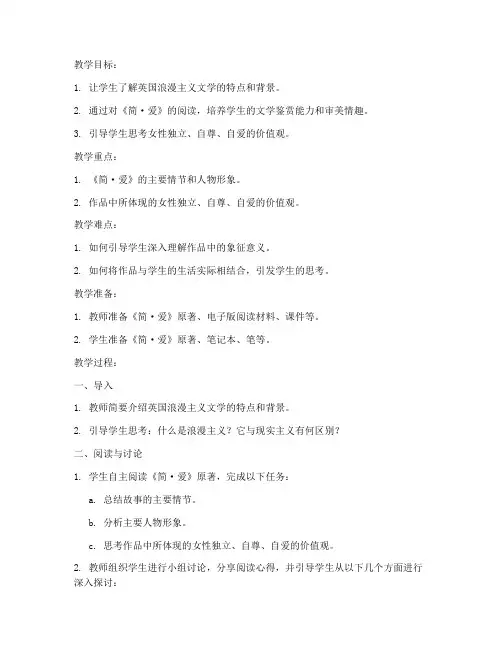
教学目标:1. 让学生了解英国浪漫主义文学的特点和背景。
2. 通过对《简·爱》的阅读,培养学生的文学鉴赏能力和审美情趣。
3. 引导学生思考女性独立、自尊、自爱的价值观。
教学重点:1. 《简·爱》的主要情节和人物形象。
2. 作品中所体现的女性独立、自尊、自爱的价值观。
教学难点:1. 如何引导学生深入理解作品中的象征意义。
2. 如何将作品与学生的生活实际相结合,引发学生的思考。
教学准备:1. 教师准备《简·爱》原著、电子版阅读材料、课件等。
2. 学生准备《简·爱》原著、笔记本、笔等。
教学过程:一、导入1. 教师简要介绍英国浪漫主义文学的特点和背景。
2. 引导学生思考:什么是浪漫主义?它与现实主义有何区别?二、阅读与讨论1. 学生自主阅读《简·爱》原著,完成以下任务:a. 总结故事的主要情节。
b. 分析主要人物形象。
c. 思考作品中所体现的女性独立、自尊、自爱的价值观。
2. 教师组织学生进行小组讨论,分享阅读心得,并引导学生从以下几个方面进行深入探讨:a. 《简·爱》中的象征意义。
b. 作品中的女性形象对现代女性的启示。
c. 如何将作品中的价值观应用到现实生活中。
三、课堂展示1. 学生代表进行课堂展示,分享自己的阅读心得和讨论成果。
2. 教师点评学生的展示,并给予肯定和指导。
四、总结与拓展1. 教师总结本节课的学习内容,强调《简·爱》的主要情节、人物形象和作品中所体现的女性价值观。
2. 引导学生思考:如何将作品中的价值观应用到现实生活中,成为一个独立、自尊、自爱的人。
五、课后作业1. 阅读原著中的其他章节,进一步了解故事情节和人物形象。
2. 结合自己的生活实际,撰写一篇关于《简·爱》的读后感。
教学反思:本节课通过阅读《简·爱》这一经典外国文学作品,让学生了解了英国浪漫主义文学的特点和背景,培养了学生的文学鉴赏能力和审美情趣。
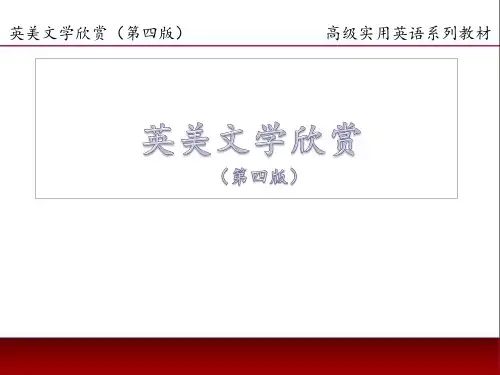
![[英语学习]文学作品赏析讲座课件](https://uimg.taocdn.com/1bbca0d808a1284ac850438f.webp)
文学作品赏析讲座课件通过作品找意境,让文学欣赏课升华至文化课,让我们的学生成为自己的主人。
How to Appreciate Poetry♦Components of A Poem :1. content2. theme3. rhythm (meter and foot)4. rhyme5. types of verse/poetic style6. image3. Rhythm (meter and foot)一. 节奏与格律♦Rhythm 节奏: 轻重声音的有规则排列就是节奏.♦Metre 格律: 诗的节奏的具体模式抑扬格: v ↗iambic iambus扬抑格:↗v trochaic /κιιεκ5υ[ρτ/ trochee抑抑扬格:v v ↗anapaestic /κιτσιπ5[νA/ anapaest扬抑抑格:↗v v dactylic /κιλιτ5κAδ/ dactyl扬扬格:↗↗Spondaic foot, spondee(扬抑格=长短格)1. We’ll learn︱a poem︱by Keats. V ↗/ V ↗/ V ↗2. Life is/ but an/ empty/ dream. ↗v /↗v /↗v /↗3. I am mon/arch of all/ I sur5vey. v v ↗/ v v ↗/ v v ↗/4. under the/ blossom that/ hangs on the/ bough.↗v v /↗v v /↗v v /↗一首诗的格律由其大多数诗行的格律所决定的。
二. Foot 音步: 英诗的节奏单位是音步是诗行中按一定规律出现的轻音节和重音节的不同组合而成的韵律的最小单位。
轻重音节是形成英语特有的抑扬顿挫声韵节律的决定性因素。
Types:monometer 一音步/[τιμPν5Pμ/dimeter 二音步/[τιμιδ5/trimeter 三音步/[τιμιρτ5/tetrameter 四音步/[τιμAρτ5ετ/pentameter 五音步/[τιμAτ5νεπ/hexameter 六音步/[τιμAσ5κεη/heptameter 七音步/[τιμAτ5πεη/octameter 八音步/[τιμAτ5κP/quatrain /νιερτPωκ5/四行节诗,韵律一般为:abab, abba.三.格律与音步1. 抑扬格: v ↗iambus; iambic foot即轻重格或短长格,一轻读音节后跟一个重读音节构成抑扬格。
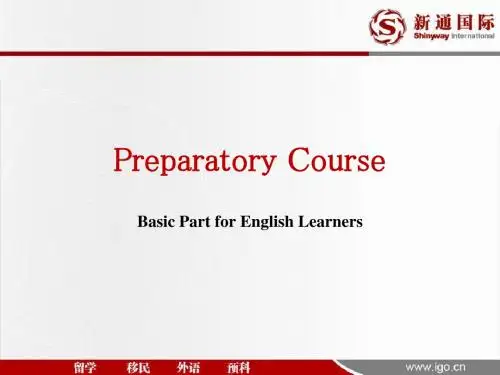
Eveline 伊芙林She sat at the window watching the evening invade the avenue. Her head was leaned against the window curtains and in her nostrils was the odour of dusty cretonne. She was tired.Few people passed. The man out of the last house passed on his way home; she heard his footsteps clacking along the concrete pavement and afterwards crunching on the cinder path before the new red houses. One time there used to be a field there in which they used to play every evening with other people's children. Then a man from Belfast bought the field and built houses in it -- not like their little brown houses but bright brick houses with shining roofs. The children of the avenue used to play together in that field -- the Devines, the Waters, the Dunns, little Keogh the cripple, she and her brothers and sisters. Ernest, however, never played: he was too grown up. Her father used often to hunt them in out of the field with his blackthorn stick; but usually little Keogh used to keep nix and call out when he saw her father coming. Still they seemed to have been rather happy then. Her father was not so bad then; and besides, her mother was alive. That was a long time ago; she and her brothers and sisters were all grown up; her mother was dead. Tizzie Dunn was dead, too, and the Waters had gone back to England. Everything changes. Now she was going to go away like the others, to leave her home.Home! She looked round the room, reviewing all its familiar objects which she had dusted once a week for so many years, wondering where on earth all the dust came from. Perhaps she would never see again those familiar objects from which she had never dreamed of being divided. And yet during all those years she had never found out the name of the priest whose yellowing photograph hung on the wall above the broken harmonium beside the coloured print of the promises made to Blessed Margaret Mary Alacoque. He had been a她坐在窗前看着黄昏涌上大街。
高中英语课程《文学作品赏析》优质课公开课教案一、教学目标1. 通过本节课的研究,学生将能够深入理解文学作品的内涵和艺术特点。
2. 培养学生的文学鉴赏能力,提升其文学素养和审美价值观。
3. 激发学生对文学创作的兴趣,培养他们的创造力和表达能力。
二、教学内容1. 引入:通过一个引人入胜的故事或诗歌引起学生的兴趣,激发他们对文学作品赏析的热情。
2. 文学作品赏析:选择一篇经典文学作品,进行深入的解读和分析。
3. 文学鉴赏技巧:介绍一些基本的文学鉴赏方法和技巧,如诗歌的韵律、修辞手法等。
4. 小组讨论:分成小组,让学生在小组内分享自己对文学作品的理解和感悟,并展开讨论。
5. 总结回顾:对本节课的主要内容进行总结回顾,强化学生对文学作品赏析的理解。
三、教学步骤1. 导入:通过一个有趣的故事或诗歌,引起学生对文学作品赏析的兴趣。
2. 文学作品赏析:选择一篇经典文学作品,进行详细的解读和分析,包括作者的背景、情感表达、主题等方面。
3. 文学鉴赏技巧:介绍一些基本的文学鉴赏方法和技巧,如对诗歌进行韵律分析、修辞手法的辨析等。
4. 小组讨论:将学生分成小组,让他们在小组内分享自己对文学作品的理解和感悟,并展开讨论。
5. 总结回顾:对本节课的主要内容进行总结回顾,强化学生对文学作品赏析的理解和记忆。
四、教学资源1. 教材:选取适合年级和学生水平的经典文学作品。
2. 多媒体设备:用于播放音频、视频等辅助教学材料。
五、教学评价1. 观察学生在课堂上的表现,包括参与讨论的积极性、对文学作品的理解程度等。
2. 收集学生的书面作业,评价他们对文学作品的深度分析和表达能力。
3. 学生的小组讨论成果和互动表现。
六、教学反思通过本节课的教学,学生对文学作品赏析方面的理解和能力得到了提升。
但在教学过程中,发现部分学生对某些文学鉴赏技巧仍存在困难,需要在后续的教学中加强。
同时,小组讨论的组织方式和引导需要更加有针对性和提升互动活跃度。
外国文学欣赏《现代文学》教案简介本教案旨在引导学生欣赏和理解现代文学作品,培养其对外国文学的兴趣和审美能力。
通过精心设计的教学内容和活动,学生将能够深入探索《现代文学》的主题、风格和文学技巧,提高他们的文学鉴赏能力和文学创作水平。
教学目标- 培养学生发现和理解现代文学作品中的主题和思想的能力。
- 培养学生分析和评价现代文学作品的能力。
- 提高学生对不同文学风格和技巧的认识和理解。
- 培养学生的写作和表达能力,激发他们的创作潜力。
教学内容单元一:现代文学概述- 介绍现代文学的定义、特点和发展历程。
- 分析现代文学作品中的主题和思想。
- 阅读和讨论一些经典的现代文学作品。
单元二:文学风格与技巧- 探索不同的文学风格,如现实主义、浪漫主义、象征主义等。
- 分析并比较不同文学作品中的风格和技巧。
- 阅读和讨论代表性的现代文学作品。
单元三:文学作品的审美价值- 培养学生评价和欣赏文学作品的能力。
- 探索文学作品中的美学、人文和哲学价值。
- 阅读和讨论一些具有较高艺术价值的现代文学作品。
单元四:文学创作和写作训练- 激发学生的创作潜力,通过写作训练培养他们的表达能力。
- 给予学生写作指导和反馈,帮助他们提高写作水平。
- 组织学生进行创作分享和评论,促进彼此的研究和成长。
教学方法- 集体讨论:学生与老师一起讨论文学作品中的主题和思想。
- 小组活动:学生分组进行文学讨论、文学研究和文学分析等。
- 阅读分析:学生独立阅读文学作品,进行深入的分析和理解。
- 写作训练:学生通过写作练提高自己的表达和写作能力。
教学评估- 课堂参与:学生积极参与讨论和活动的程度。
- 作业完成:学生按时完成分配的阅读和写作任务。
- 文学分析报告:学生撰写的文学分析报告的质量和深度。
总结通过《现代文学》教案的实施,学生将能够系统化地学习和欣赏外国现代文学作品,培养自己的文学鉴赏能力和创作潜力。
此教案将为学生提供一个丰富多样的学习环境,帮助他们更好地理解和掌握外国文学的精髓。